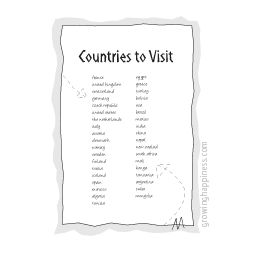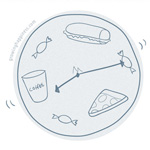September Ends, A New Habit Develops?
Last day of Nablopomo September. This is the second time I’ve participated in this daily writing project and like the previous time, towards the end, I get a bit er…lazy. I didn’t have a plan/stuck to the theme this time round. Some notes:
I’m not very good at doing this everyday, especially on weekends. My weekends are usually spent away from the computer, unless I really have to do some work.
It’s not everyday that I have something worth posting. So some posts suck. I feel bad for my readers.
I read that writing regularly can help improve your writing however this exercise has not made me a better writer. Writing well-crafted posts regularly may improve one’s writing but to do that everyday no matter what is a little difficult (not impossible) for someone like me whose ideas tend to come in sporadic, tiny clouds of inspiration.
I do find myself writing slightly faster now. I stop overthinking every little detail of my post before hitting the “publish” button.
I heard that it takes 30 days to form a habit. I don’t think I have developed daily writing habit. Yet.
I really admire folks who can write beautifully on a daily basis. Will I be doing this again in future? Maybe, maybe not. As it stands, I feel I’m doing my readers a disservice by forcing myself to post everyday whether or not there was something worth posting. But it is a lot of fun to look back and read fragments of thoughts preserved in writing here. I guess that’s why we keep journals.
Have you ever committed yourself to writing daily?
Bad Sleep Day - Polyphasic Sleep Update
Despite being really tired yesterday (running around a number of places lugging two heavy bags continously for 6 hours), I was well-rested and productive at night:
Yesterday
6.30am-12.30am: Sleep
1-7pm: On my feet
8pm-11pm: Slept 3 hours. Woke up refreshed
11pm-6.30am: Work

Today is a different story. I had 3 interrupted sleep periods and was very sleepy and unproductive the whole day.
Today
7am-9.45am: Slept for 2hr45min, woken up by a phone call
9.45am-1.45pm: Work
1.45pm-2pm: Decided to do some light workout. Still sleepy
2pm-3pm: Took a nap
3pm-4pm: Phone rang. Talked for an hour
4pm-9pm: Home
9pm-11.30pm: Intended to sleep for 3 hour but awaken by cat at hour 2.5. Another interrupted sleep cycle means waking up feeling terrible.

Here’s a nicely illustrated article on How to Nap. It should have included the all-important tip — “Remove cat from room.”
Improvement to the current natural polyphasic sleep system: I will limit my afternoon naps to between 20 and 45 minutes on days I’m expecting an important phone call by setting an alarm.
Natural Polyphasic Sleep Pattern
I’ve fallen into a biphasic/polyphasic sleep pattern the last couple of months. I didn’t plan this but it seems to be doing me a lot of good so far. A weekday may go something like this:
9pm-4am (7hr): Work
4am-8.30am (4.5hr): Sleep
8.30am-4pm (7.5hr): Work + Nap (90min-3hr)
4pm-9pm (5hr): Home (family time, cooking, cleaning)
I usually sleep 4.5 or 6 hours straight for my main sleep period. The total number of hours for this is usually in multiples of 90 minutes, which is a unit of my sleep cycle (in case you’re wondering, I wake up to a giant Ikea clock so it’s really easy to tell the time). To wake up at the end of one of these 1.5-hour cycle is ideal – I’ll feel well rested and will wake up without any grogginess.
The duration of my nap in the day depends on how much I got for my main sleep period at night. I wake up mid-cycle during my naps a little more often than my main sleep period because of phone calls.
The best day (feeling full of energy, brimming with ideas, very productive) I had this week was polyphasic that went like this:
6am-9am (3hr): Sleep
9am-1pm (4hr): Work
1pm-4pm (3hr): Sleep
4pm-9pm (5hr): Home
9pm-10.30pm (1.5hr): Sleep
10.30pm-5am (6.5hr): Work
5am-10am (6hr): Sleep
Getting used to Biphasic or Polyphasic Sleep Pattern
A divided sleep pattern may or may not be for you. Many people I know are satisfied and perform well with the usual monophasic sleep pattern. If you are one of these people, I don’t see why you need to change your sleeping habits. But if you are like me, always struggling to stay at my peak performance level in throughout the day, then this is worth a shot.
People starting on a biphasic sleep routine may experience extreme sleepiness during the first few days. I think, and this is not supported by any research, it is better to gently ease yourself into it instead of forcing yourself to conform to a fixed time. Everyone is different and you know your own body best, so it’s difficult to follow someone else’s sleep routine with the same amount of success they had.
Here’s a suggestion (again, this is just a suggestion, you know your body best). You can start by identifying how long is your sleep cycle is (do this on a weekend or when you’re not working). Then reduce the amount you sleep at night by one sleep cycle (if you are currently doing 5 cycles of 90 minutes, try 4 x 90 instead). You will find that some time in the middle of the day you need to take a nap, go ahead. I do not set a specific time I need to be asleep/wake.

Benefits of Polyphasic Sleep
Higher energy/More productive hours
One of the main benefits is that my alertness level is on an all-time high. That dip in the middle of the day is now replaced by a reviving nap. I had also long suspected I’m a nocturnal worker and this is proven true in the current system — I’ve accomplish so much more (completed nearly twice normal workload) during the main work shift at night. I’ve also managed to sneak in a couple of minutes of workout daily now. So for people who have the tendency to feel sluggish in the middle of the day or who work best in the quiet of night, you may wanna try biphasic or polyphasic sleep.
Less stress
Dividing my work day into two shifts has yielded incredible results. I feel less stressed about work in the day. I like to do a lot of planning and brainstorming before delving into the actual work stuff so to know that I have another shift at night is great. It’s like I have an additional work day every day.
Improve international relations (!!!)
I respond to clients from different time zones more promptly now because I am working “round the clock”. I can see full-time bloggers taking advantage of this system, especially when you audience is a few GMT hours ahead or behind you.

When Biphasic or Polyphasic Sleep Might Not Work
While Travelling
Though my current sleeping habit started when I was traveling by rail around Europe (a couple hours here and there), I don’t see a good way you can incorporate a nap into a day of sightseeing. Unless of course, you are traveling on your own RV.
When the other half is not a willing participant
To actually have long-term success with segmented sleep, one may need to sleep alone or have a partner who is willing to be on a similar sleeping pattern. Lucky for me my husband and I sleep around the same times.
Days when you need to meet multiple clients/friends
Well, your social life have to continue, right? Unless you choose exist only in the virtual world or get all your friends and family into this.
You work in an office/outdoors/need to stick to certain work hours
A few offices have introduced power naps to increase productivity of their staff but overall but this is still not the norm.

Notes
- I don’t have an alarm clock set unless I have an appointment. When I feel sleepy, I just go to bed, when I have enough rest, I’ll naturally wake up.
- I have a cup of coffee on weekdays, anytime from 10am-4 pm. It doesn’t seem to affect my naps.
- I usually adopt a monophasic sleep pattern on Saturdays because I am out and about doing stuff. I zonk out after lunch but this is fixed with an espresso.
- Before this I usually sleep about 7 hours at night. I bought into the believe that 7 or 8 hours of sleep is the ideal time for an adult human and set my alarm accordingly. I didn’t know much about sleep cycles then. 7.5 hours is ideal for me but that doesn’t stop me from feeling drowsy in the middle of the day.
- I have been having more lucid dreams these past few weeks. In one of the dreams, I made Daniel Craig meet me in Thailand. In a tux. As James Bond. And then we built a school for disadvantaged kids. Ahem!
Wouldn’t It Be Great If…
Shopping Was Exercise?
I’ve just started walking to keep fit. I have clocked 20 hours in the past week. And it all started with a post-Christmas sales shopping spree.
You see, I only shop for clothes about 3-4 times a year but it’s usually a multiple-day affair for me — 1 day to plan and check out styles in magazines or websites; 1-3 days to scour ALL the clothing racks in town, a day to decide whether I really need whatever I’ve singled out in the stores, and another day to actually buy the stuff. I’m probably the least impulsive shopper you’ll ever meet and have annoyed practically everyone who’s ever been shopping with me — even my mom. Which is why I now only shop alone. She doesn’t get why I need to think so hard about buying a $10 pair of sandals. To me, $10 spent on something I’m not gonna use regularly is $10 wasted. (However, this habit does not extend to other areas of my life like buying snacks for myself (unfortunately) — “$16 for a tub of ice-cream? Sounds delicious!” — or buying gifts for others (fortunately) — “$80 for a box of fine chocolates? Why not? She’s worth it!”)
Anyway, I realised that I could spend up to 8 hours a day on my feet, walking briskly from mall to mall, trying to find the perfect shirt at the perfect price and this exercise proved to be quite a work out. A hugely satisfying one. Why not create a fitness regime based on shopping, I thought? So with that in mind, my Shoppercise programme is born. It goes something like this:
- I’ll award myself $5 of spending money at the end of each hour of walking (window shopping).
- Unspent allowance will be brought forward to the next hour. So if I want to spend $20 on a t-shirt, I’ll need to walk 4 hours to earn it. A lot of work for a bit of money, but that’s the point.
- At the end of the day, I either have something new in my wardrobe that I had “exercised” for, or earn a few dollars of somewhat guilt-free (I “earned” it by burning calories, right?) shopping allowance.
- Repeat every week until I get sick of this scheme.
Still on the topic of walking, I have recently discovered a park with a mangrove forest just a 15-minute walk away from my apartment. I was there yesterday and saw a monkey, a huge spider and so many species of plants I’ve never seen before. The whole trail takes about an hour and a half to cover and I can see myself going there at least once a week.
Aiming for the World
When I’m presented with the question, “What would you like to do before you get too weak/retire/die?” I’ve always answered “travel around the world.”
Earlier this week I was spending some time setting goals for 2009. One of the things I did was to list out a few countries I’d like to visit next year. After I’ve done that I decided to expand this exercise by listing out all the countries I’d love to visit and realised that I don’t really want to go to every country of the world like what Chris is doing. I only really want to go to 30 (plus 20 more that would be “nice but are not must go’s at the moment”). What a revelation! I’ve always thought the number would be closer to 100 but 30 sounds very achievable. So I went on to list done the feasibility of visiting these 30 countries.

If I were to visit a country each year, I’d achieve my dream in 30 years. That’s alright, but that’s not very efficient. I could tackle the countries by regions, dividing them into the following: Western Europe, Scandinavia, Northern Africa, North America, Latin America and Eastern & Southern Asia. After working out a very rough estimate, I reckon I’d need about $6000 per one month trip to a region (it is possible to go on a much lower budget but I’m not planning to rough it out. Yet.). Quite a bit of money, but if I were to aim to cover a region say every three years, that would work out to less than $170 a month or under $6 a day.
Can I actually save $42 a week? Let’s see… My once a week cafe time costs $5. Our weekly movie date, $40. Magazines? $5. And I also have a habit of buying huge amounts of snacks each week – up to $25- worth. That’s a total of $75. If I were to save a little over half of that, I’d still have more than enough change to rent a film and get some popcorn. Of course the other question is, can I afford to take leave off work for a whole month? At this moment, the answer is no, but I think I’ll worry about that later. I realised that when you set a goal and work towards it, things have a way of working out in your favour unexpectedly and faster than you’d imagine so we’ll see. :)
Amazing Vision - Mahatma Gandhi
Here’s my response to the Amazing Visions writing challenge by Damien Riley of Postcards from the Funny Farm.
![]()
My school was divided into houses which was named after inspirational figures in international history and my class came under the Mahatma Gandhi house. That was the first time I heard of the man but it was only after I watched the movie Gandhi, directed by Richard Attenborough and convincingly played by actor Ben Kingsley, that I learned about what he stood for and the profound impact this unassuming man had in the history of India and the world.

Born Mohandas Karamchand Gandhi in British India in 1869, he was given the title Mahatma, meaning Great-Soul, by poet and Nobel Literature Prize winner, Rabindranath Tagore. The turning point in his life occurred in South Africa, where he worked as a legal adviser for 21 years, and in the process witnessed firsthand, the crippling effects of racism. It was there that he coined the term “satyagraha”, his philosophy and practice of non-violent resistance. Returning to India, Gandhi played a major role in establishing India’s independence against British rule. Once again he used his most powerful weapon against the injustice — non-cooperation and peaceful resistance.
Despite the change he effected and being nominated for the Nobel Peace Prize 5 times, “the strongest symbol of non-violence in the 20th century” was never awarded the Nobel Peace Prize. But Gandhi was never one for adulation and awards, being as humble about his influence to the world as he was sure about the power that exists in everyone of us:
“I claim to be no more than an average man with less than average ability. Nor can I claim any special merit for such non-violence or continence as I have been able to reach with laborious research. I have not the shadow of a doubt that any man or woman can achieve what I have, if he or she would make the same effort and cultivate the same hope and faith.”
Mahatma Gandhi
Gandhi dedicated his life to the discovering the ultimate Truth, and did so by conducting experiments on himself and learning from his own mistakes. The result of these experiments with truth and non-violence is a legacy that lives on, decades after his assassination, influencing and inspiring people all over the world from Martin Luther King Jr, leader in the American civil rights movement, to Nelson Mandela, anti-apartheid activist and former president of South Africa.
One of his many admirers, Albert Einstein, who had exchanged letters with him, had this to say:
“Generations to come will scarce believe that such a one, as this (Gandhi), ever in flesh and blood walked upon this earth.”
Albert Einstein
There may come a time when Gandhi’s remarkable story is taken as mere folklore but his ideology will always remain important and timeless.
![]()
Who has been a great inspiration to you? Why not share your thoughts on Amazing Visions? Entries open till end of the month.







